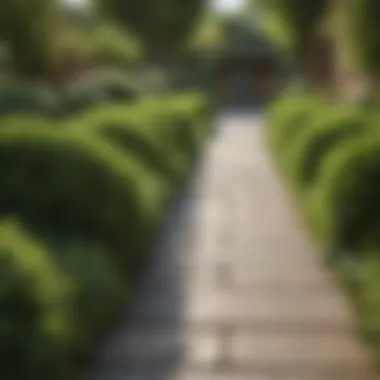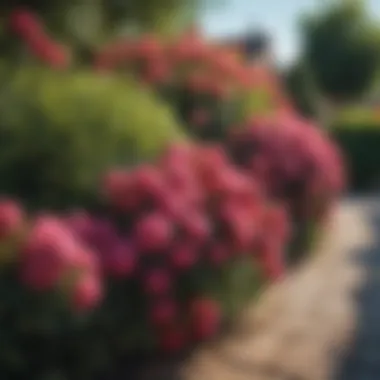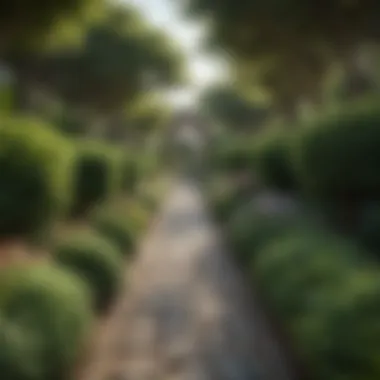Enhance Your Walkways with Beautiful Shrubs


Intro
The integration of shrubs into walkway designs is a transformative approach that enhances both practicality and aesthetic appeal in outdoor spaces. Shrubs serve multiple purposes: they provide natural beauty, create a welcoming environment, and complement other landscape elements. As homeowners and gardening enthusiasts consider their outdoor layouts, understanding the types of shrubs suitable for walkways becomes critical. This guide explores the various options available, maintenance requirements, and effective placement strategies to elevate the overall landscape.
Shrubs not only enhance visual interest but also contribute to defining pathways, ensuring easy navigation through gardens and yards. The selection of appropriate shrub types can vary greatly based on climate, design preferences, and specific functional needs. Therefore, recognizing the key choices available is crucial for creating an inviting atmosphere that impresses guests and pleasures the inhabitants.
This exploration of shrubs will offer detailed insights into practical selection, care requirements, and design inspiration, catering specifically to the needs of homeowners seeking to elevate their outdoor environments.
Understanding the Role of Shrubs in Walkways
Shrubs serve a vital function in walkway design, influencing both usability and aesthetics. When selected and placed correctly, they can enhance the overall experience of outdoor spaces. This section discusses the importance of shrubs in walkways, emphasizing their practical use and visual appeal.
Functionality of Walkway Shrubs
Functional benefits are crucial to consider when choosing shrubs for walkways. Firstly, shrubs can provide natural barriers that help define the path. This definition guides visitors and keeps foot traffic steady on designated walkways. Furthermore, shrubs can contribute to safety by adding a layer of protection. For instance, low-growing shrubs can obscure potential hazards like uneven ground.
Additionally, shrubs can aid in controlling foot traffic. By strategically placing shrubs along the edges of a path, gardeners can direct movement. This technique can prevent people from wandering into flower beds or other sensitive areas. Furthermore, shrubs may also play a role in soil erosion prevention, helping to anchor the soil when planted appropriately.
In terms of environmental functionality, shrubs promote biodiversity. They can provide habitats for beneficial insects and small wildlife. Choosing the right mix of shrubs can lead to balanced ecosystems, enhancing the outdoor experience for all who visit.
Aesthetic Contributions to Walkway Design
Aesthetic contributions of shrubs cannot be understated. They add softening elements to hardscapes, creating inviting pathways. The variety of shrub species provides options for color, texture, and seasonal interest. For example, evergreens offer lush greenery year-round, while flowering shrubs add blooms during specific seasons. This seasonal variety keeps the landscape engaging even as seasons change.
Using shrubs also allows for creative design opportunities. They can be layered in heights, creating depth in the landscaping. This layering effect can make walkways appear more dynamic and attractive. In addition, contrasting colors and shapes can enhance visual interest. For instance, pairing round-leafed shrubs with spiky ones adds complexity to the setting.
In summary, shrubs not only provide functional benefits to walkways but also elevate the aesthetic experience. Their roles should not be overlooked when planning or designing outdoor spaces.
Selecting the Right Shrubs for Walkway Areas
Choosing the appropriate shrubs for walkway areas is essential for creating a beautiful and functional outdoor space. The right selections can improve the overall aesthetics and enhance the usability of the walkways. A well-planned shrub arrangement can also provide benefits such as increased privacy, reduced noise, and improved air quality. Understanding various shrub characteristics and site conditions is critical for making informed decisions.
Factors to Consider in Shrub Selection
Climate and Hardiness Zones
Climate and hardiness zones play a significant role in shrub selection. Plants must be able to survive and thrive in specific environmental conditions, including temperature, humidity, and precipitation levels. The hardiness zone provides a guide to what shrubs will grow well in a particular area.
One important characteristic of hardiness zones is that they help gardeners choose shrubs that can withstand local climate extremes. For this article, this aspect ensures that selected shrubs are resilient and less likely to suffer from stress. The unique feature here is the USDA plant hardiness zone map, which provides detailed information for regions across the US.
Benefits include reduced maintenance and enhanced success rates when planting. However, a potential disadvantage is that success can only be guaranteed if the plants match the hardiness zone accurately.
Soil Type and Quality
The type and quality of soil are equally vital in shrub selection. Different shrubs have varying preferences for soil texture, pH, and drainage qualities. This characteristic directly impacts their growth and health. A beneficial choice for publication involves understanding local soil conditions, which aids in selecting compatible shrub types.
Unique features include the need for soil testing to determine nutrient levels and amendments. The advantage of matching shrubs to favorable soil conditions is the assurance of better growth rates and fewer diseases. On the downside, poor soil quality can necessitate extensive preparation work, making some options less feasible.
Sunlight Exposure Requirements
Sunlight exposure is a crucial aspect when selecting shrubs. Each shrub has specific sunlight needs, from full sun to partial shade. Understanding these requirements ensures that the chosen plants will flourish.
A key characteristic here is that planting shrubs inappropriately can lead to stunted growth or mortality. This article emphasizes the importance of knowing both the sunlight preferences of the selected shrub and the local conditions. The unique feature is the need to observe sunlight levels throughout the day in the target area.
The advantage of matching shrubs to their light exposure is vibrant growth and flowering. However, the challenge can arise in shaded areas where fewer shrub options may be viable.


Popular Shrub Varieties for Walkways
Selecting popular shrub varieties is essential for achieving functional and stylish walkways. The following classifications summarize suitable options based on height, seasonal change, and foliage characteristics.
Low-growing Shrubs
Low-growing shrubs are suitable for borders along walkways. They provide a clean look without obstructing views or pathways. Their key characteristic is a compact growth habit, making them ideal for limited spaces. In this article, low-growing shrubs can enhance accessibility while providing visual appeal.
An example of a low-growing shrub is the dwarf spirea. A unique feature is their resistance to pruning, which simplifies maintenance. Advantages include minimal space requirements. However, the disadvantage can be reduced visual impact when using taller plants alongside them.
Deciduous Shrubs
Deciduous shrubs can create seasonal interest in walkways. These plants shed their leaves in autumn, often revealing interesting branch structure or fruit. A key characteristic is the seasonal change in appearance, which adds a dynamic element to landscape design.
Choosing deciduous shrubs, like the butterfly bush, presents the opportunity for vibrant flower displays. The unique feature is their ability to attract pollinators. However, a potential drawback is the periodic absence of foliage, which may not suit all designs.
Evergreen Shrubs
Evergreen shrubs provide year-round structure and color to walkways. Their key characteristic is the consistent presence of lush foliage, serving as a backdrop for seasonal blooms. This article highlights evergreens' value for creating a cohesive look regardless of the season.
Examples of evergreen shrubs include Boxwood and Juniper. A unique feature of evergreen shrubs is their ability to offer privacy and noise reduction, beneficial for bustling locations. Advantages encompass low maintenance and robustness. The disadvantage involves potential overgrowth, necessitating regular upkeep to maintain desired shapes.
Design Considerations for Shrubs Along Walkways
The placement of shrubs along walkways significantly impacts aesthetic appeal and functionality. When chosen with thought, shrubs provide visual variety and enhance the outdoor space. The design considerations for shrubs are not solely about looks. They involve balance, dimension, and how well the shrub integrates with the surrounding environment. By paying attention to spacing, arrangements, and combinations with other plants, one can create a walkway that is both attractive and engaging.
Spacing and Arrangement Techniques
Plant Density and Growth Patterns
Plant density is a critical aspect to consider when designing with shrubs. High-density planting can create a lush, full appearance, but it often comes with challenges. Plants need space to grow; crowded shrubs may suffer from inadequate air circulation and competition for nutrients. A well-planned density allows shrubs to thrive, contributing positively to the overall design.
The main characteristic of plant density is its ability to create a uniform look or a more diverse arrangement. When shrubs are too closely packed, they can lead to disease problems. Conversely, too much space can result in a sparse look that lacks presence. Therefore, adjusting the distance between plants according to their projected size and growth patterns is beneficial for a balanced design. Finding that ideal spacing encourages healthy growth while maintaining a cohesive aesthetic.
Layering for Visual Depth
Layering is another design technique that enhances depth in shrub arrangements. By varying the heights and sizes of shrubs, one can create an inviting and dynamic visual experience. This approach allows for eye movement through the landscape, which can draw visitors in.
The key characteristic of layering is its versatility. It enables designers to utilize a variety of shrub types, ensuring that lower growth does not obscure taller plants. Layering creates a natural look. Its advantage lies in the ability to make even small spaces feel larger and more dynamic. However, one must be careful; improper layering may lead to overshadowing, where smaller plants are deprived of necessary light.
Combining Shrubs with Other Plantings
Combining shrubs with other types of plantings helps enrich the ecosystem of a walkway. By integrating different plants, one can enhance not just beauty but also biodiversity. This encourages a sustainable environment where all plants can thrive together.
Integrating Perennials
Integrating perennials provides a variety of colors and textures, complementing the shrubs while ensuring seasonal interest. The key benefit of using perennials is their ability to return year after year, creating a reliable source of beauty and interest. They work well alongside shrubs, softening hard edges and filling in gaps. However, one must consider the specific needs of each perennial type to ensure they harmoniously coexist with the shrub’s growth requirements.
Blending with Ground Covers
Blending shrubs with ground covers creates a seamless transition between plant types. This method can stabilize soil and reduce weed growth. Ground covers can fill spaces effectively while allowing shrubs to stand out. A unique feature of ground covers is that they can prevent soil erosion while enhancing the visual appeal. However, choosing the wrong ground cover can lead to overpowering the shrubs or competing for resources. Careful selection ensures they complement each other rather than create conflicts in growth.
The design of a walkway with shrubs considers not only aesthetic factors but also the health of the plants and the environment as a whole.
In summary, understanding the design considerations for shrubs along walkways is crucial. The right arrangements promote health, beauty, and overall efficiency in outdoor spaces.
Maintenance of Shrubs in Walkway Settings


Maintaining shrubs in walkway settings is crucial not only for the longevity of the plants but also for the overall aesthetic appeal of a landscape. Well-maintained shrubs can enhance the beauty of a walkway, providing structure and depth to the outdoor space. Regular care ensures that shrubs remain healthy and vibrant, ultimately contributing to a more inviting environment. Understanding the key aspects of shrub maintenance can also prevent common issues, allowing homeowners to enjoy their landscaping efforts without frequent intervention.
Watering and Irrigation Strategies
Effective watering is paramount for the survival of shrubs along walkways. The frequency and method of watering depend on several factors, including the specific shrub variety, weather conditions, and soil moisture levels.
When it comes to irrigation, drip systems are often the most efficient choice. They deliver water directly to the base of the shrubs, minimizing waste and ensuring that plants receive adequate moisture. This method is particularly beneficial for regions with scarce water resources. In contrast, more traditional overhead watering can leave shrubs susceptible to fungal diseases due to excess moisture on leaves.
As a rule of thumb, it is better to water deeply and less frequently rather than lightly and often. Deep watering encourages root growth, allowing the shrubs to better withstand dry conditions. Additionally, time of day matters; watering in the early morning reduces evaporation and helps prevent disease.
Pruning Techniques for Healthy Growth
Pruning is another essential component of shrub maintenance that ensures healthy growth and overall vitality. Proper pruning helps to remove dead or diseased branches, encourage new growth, and maintain the desired shape of the shrub.
A general guideline is to prune during the late winter or early spring, before the new growth begins. This timing allows the plant to heal quickly and promote bushier growth. Each shrub variety has its own specific pruning requirements; therefore, a homeowner should familiarize themselves with the particular needs of the shrubs they have planted.
When pruning, follow these steps:
- Use clean and sharp tools to make clean cuts.
- Remove any dead, damaged, or crossing branches.
- Avoid over-pruning, which can stress the plant.
Fertilization Practices
Fertilization plays a significant role in the growth and health of shrubs in walkway settings. A balanced approach to fertilization will ensure that shrubs receive the necessary nutrients.
Many homeowners overlook the importance of soil testing, which provides valuable information about nutrient levels. Based on test results, it is possible to apply the right type of fertilizer—be it organic or synthetic. Organic fertilizers, like compost or well-rotted manure, are excellent choices as they improve soil structure while providing nutrients.
Typically, shrubs benefit from fertilization during the growing season, particularly in spring and early summer. However, caution is needed; over-fertilizing can lead to excessive growth that makes shrubs susceptible to pests and diseases. As a recommendation, it is better to under-fertilize than over-fertilize.
In summary, regular maintenance of shrubs along walkways enhances their health, vitality, and aesthetic appeal. Watering, pruning, and fertilizing are the three key practices that will ensure that these plants thrive and contribute positively to the landscape.
By understanding and applying these maintenance techniques, homeowners can significantly impact the appearance and longevity of their walkways.
Environmental Considerations for Shrubs
Incorporating shrubs into walkway designs requires more than aesthetic vision. It involves a conscientious approach to environmental factors that promote healthy growth and sustainability. Understanding the interaction between shrubs and their surroundings can significantly influence the success of the landscape design. This section evaluates soil health, compatibility with plants, and sustainable shrub choices.
Soil Health and Shrub Compatibility
Soil is the foundation for any successful planting, and shrubs are no exception. Healthy soil is crucial for providing essential nutrients, water retention, and proper drainage. When selecting shrubs, consider the compatibility between the plants and the existing soil conditions. Conducting a soil test can reveal pH levels and nutrient content, guiding you to shrubs that thrive in those specific conditions.
- Nutrient-Rich Soil: Opt for shrubs that prefer nutrient-rich soil for vibrant growth.
- Soil pH: Different shrubs prefer specific pH levels—some are acid-loving while others prefer alkaline soil.
- Organic Matter: Adding compost or organic matter can enhance soil structure and support shrub vitality.
Shrubs such as Hydrangeas and Boxwoods often show resilience in adaptable soil environments. Avoid plants that may be invasive or detrimental to native species in your area. Compatibility extends beyond soil to surrounding flora, which can impact growth patterns.
Sustainable Shrub Choices
Sustainability is an essential aspect of modern landscaping. With climate change concerns and the need for biodiversity, choosing sustainable shrubs offers numerous environmental benefits. Selecting native species not only supports local wildlife but also reduces the need for chemical interventions and excessive water usage.
- Native Shrub Varieties: Plants like Elderberry and Bladderwort adapt well to their local environment and attract beneficial insects.
- Drought-Tolerant Shrubs: Consider shrubs like Sagebrush or Lavender that thrive in dry conditions, minimizing water usage.
- Low-Maintenance Options: Selecting shrubs that require less pruning and fertilizers can contribute to a low-impact landscape.
"Native plants are the backbone of sustainable landscapes, providing stability and resilience while supporting local ecosystems."
When creating walkways, it is vital to emphasize environmentally-friendly practices. Integrating shrubs that require fewer resources promotes sustainable gardening approaches that enhance ecological health. Additionally, it encourages consideration of the broader impact of landscaping choices on the environment.
Troubleshooting Common Shrub Issues
Incorporating shrubs into walkway designs presents numerous advantages, but it also invites potential challenges. Addressing these issues is crucial for maintaining the health and appearance of the shrubs, which ultimately impacts the overall aesthetic of the walkways. Understanding how to troubleshoot common shrub issues allows homeowners to keep their landscapes flourishing. This section will explore pest management, disease control, and the ability to identify environmental stress factors affecting shrub health.


Pest and Disease Management
Pests and diseases can severely hinder shrub growth and compromise their visual appeal. Recognizing common pests, such as aphids, spider mites, and leafhoppers, is vital. These insects often feed on the leaves and stems, leading to stunted growth and leaf distortion.
Organic pest management strategies are effective and more environmentally friendly. Options include:
- Insecticidal soaps: These disrupt the life cycles of pests without harming beneficial insects.
- Neem oil: This natural insecticide deters pests while promoting plant health.
- Companion planting: Certain plants can repel unwanted insects naturally.
Alongside pests, diseases like powdery mildew, leaf spot, and root rot can afflict shrubs. Early detection is key, as many diseases can spread quickly. Keeps an eye out for:
- Unusual leaf discoloration or spots.
- Wilting plants despite adequate watering.
- Fungal growth on plant surfaces.
Pruning away affected areas and improving air circulation can prevent the spread of these diseases. Regular inspections and prompt action can save affected shrubs.
Identifying Environmental Stress Factors
Environmental stressors play a significant role in the health of shrubs. These factors often manifest through various symptoms, such as browning leaves or reduced growth. Common stress factors include inadequate light, poor soil conditions, and improper watering practices.
Here are some signs of environmental stress to monitor:
- Leaf discoloration: Yellowing may indicate insufficient nutrients or water.
- Wilting: This can suggest both overwatering and drought stress.
- Stunted growth: Can result from poor soil conditions or lack of sunlight.
Correctly identifying the underlying cause is essential. For instance, if shrubs do not receive enough sunlight, consider relocating them or selectively pruning surrounding plants for better light access. Additionally, testing soil pH and nutrient levels can inform fertilization decisions.
Monitoring environmental conditions regularly can enhance the resilience of shrubs. Strategies such as mulching to retain moisture and using organic fertilizers can provide needed nutrients and improve soil health.
Effective management of pests, diseases, and environmental stressors not only preserves the integrity of shrubs but also maintains the overall beauty of walkway designs.
Case Studies: Successful Shrub Applications in Walkways
The incorporation of shrubs into walkway designs serves not just an aesthetic function but also enhances practical aspects of outdoor spaces. Examining case studies provides insights into effective shrub applications in walkways. These examples illustrate how shrubs can improve both the beauty and usability of pathways, inspiring homeowners and designers to rethink their landscape choices.
Residential Walkway Designs
In residential settings, the effective use of shrubs along walkways often enhances curb appeal. For instance, consider a typical suburban home where the entryway is flanked by neatly arranged boxwoods. These evergreen shrubs provide year-round interest and a formal appearance, guiding visitors toward the front door.
When designing a residential walkway, it is essential to think about scale and proportion. Selecting shrubs that match the size of the walkway creates harmony. Compact varieties like Spirea or Dwarf Alberta Spruce are excellent choices for narrower paths, providing greenery without overwhelming the space.
Additionally, layering shrub heights can give visual depth. For instance, smaller flowering shrubs positioned in front of taller specimens like Hydrangeas can create a pleasing arrangement. Not only is this visually attractive, but it also ensures that lower plants receive adequate sunlight while being showcased by the taller plants behind them.
Public Spaces and Community Gardens
Public spaces provide a unique landscape where shrubs play a pivotal role. In a community garden setting, shrubs can serve several purposes beyond mere decoration. They can act as natural dividers, delineating spaces for different types of plants or activities while also drawing attention to pathways.
For example, Lavender shrubs along a walking path not only encourage visitors to take a stroll but also promote sensory engagement with their fragrant foliage. Additionally, their positioning can help define areas for seating or gathering. This can encourage social interaction among community members.
Moreover, the choice of native shrubs contributes significantly to sustainability. Native plants like Ninebark and Serviceberry attract local pollinators and provide habitat, thereby supporting biodiversity in urban areas. Understanding the benefits of these plants helps in making informed decisions that benefit both the community and the environment.
Implementing case studies of successful shrub applications demonstrates their multifaceted benefits in various settings. Whether it's the aesthetic appeal in residential areas or the practicality and ecological value in public spaces, the strategic use of shrubs in walkways can transform outdoor environments.
Ending: The Lasting Impact of Shrubs on Walkway Aesthetics
In the exploration of shrubs for walkways, it becomes clear that these plants offer valuable contributions beyond mere function. Shrubs have the power to enhance the visual appeal of walkways, turning routine passages into aesthetically pleasing experiences. From subtle frames that guide visitors along paths to bold statements that command attention, the right shrub selections can vary greatly in effects.
One important aspect is the role of shrubs in creating a cohesive landscape design. When thoughtfully integrated, they link different elements of a garden or outdoor space, adding layers of interest. This seamless flow promotes harmony and invites users to engage more fully with their surroundings.
Key benefits include:
- Color Variety: Seasonal changes in foliage and blooms introduce a palette that evolves throughout the year. This dynamism contributes to a lively landscape.
- Texture Contrast: Different shrub types add tactile diversity, which can make walkways feel more inviting. The combination of broad-leaved and needle-like foliage, for instance, creates visual intrigue.
- Wildlife Support: Incorporating certain shrubs can also attract birds and beneficial insects, fostering a vibrant ecosystem along your path.
"Shrubs are not just filler; they are integral to a well-rounded outdoor experience that harmonizes beauty with utility."
However, it’s not just about aesthetics. Maintenance considerations should also be forefront in the minds of homeowners and gardening enthusiasts. Properly chosen and maintained shrubs can endure the test of time in a variety of conditions, thereby ensuring their lasting presence in the landscape. This commitment to care and thoughtful selection can yield lasting improvements in overall property value, as well as enjoyment.



